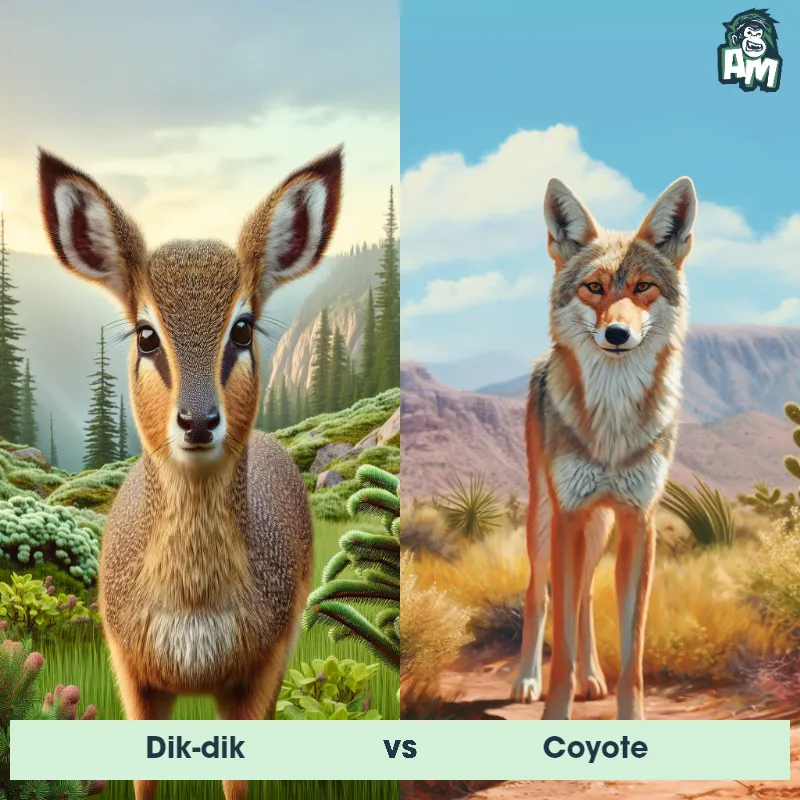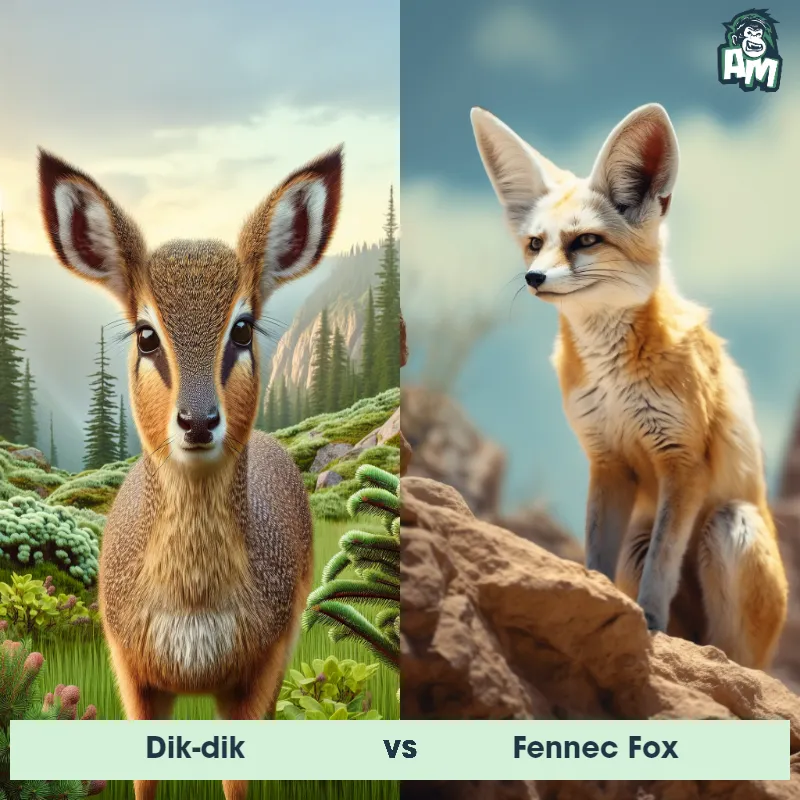The Dik-dik
The Dik-dik, also known as the Kirk's dik-dik, is a small antelope species found in eastern and southern Africa. Standing at approximately 12-16 inches tall and weighing around 7-15 pounds, they are one of the smallest antelopes in the world. They have a reddish-brown to grayish-brown fur, with a distinctive white underside and black markings on their face. Dik-diks have elongated snouts and large, dark eyes, which help them have a keen sense of smell and excellent vision, allowing them to detect predators from a distance. They are known for their agility and ability to leap up to 6 feet in the air and up to 3 feet high, allowing them to navigate through dense vegetation.

| Dik-dik | |
|---|---|
| Size | Height: 12-16 inches (30-40 cm), Length: 25-35 inches (60-90 cm) |
| Weight | 6-14 pounds (3-6 kg) |
| Speed | 26mph (42km/h) |
| Key Strength | Speed and agility |
| Biggest Weakness | Lack of physical strength |
| Scientific Name | Madoqua kirki |
| Family | Bovidae |
| Habitat | Scrub, savannah, and woodland areas |
| Geography | Eastern and southern Africa |
| Diet | Leaves, fruits, shoots |
| Lifespan | 10 years - 15 years |

The Dik-dik
The Dik-dik, also known as the Kirk's dik-dik, is a small antelope species found in eastern and southern Africa. Standing at approximately 12-16 inches tall and weighing around 7-15 pounds, they are one of the smallest antelopes in the world. They have a reddish-brown to grayish-brown fur, with a distinctive white underside and black markings on their face. Dik-diks have elongated snouts and large, dark eyes, which help them have a keen sense of smell and excellent vision, allowing them to detect predators from a distance. They are known for their agility and ability to leap up to 6 feet in the air and up to 3 feet high, allowing them to navigate through dense vegetation.
Fun Fact: Unlike many other antelopes, the Dik-dik is known for being monogamous, forming lifelong pairs. They live in small territories, and the male will diligently mark the boundaries of their home range with secretions from glands on their feet, ensuring that other Dik-diks know they are trespassing.
| Dik-dik | |
|---|---|
| Size | Height: 12-16 inches (30-40 cm), Length: 25-35 inches (60-90 cm) |
| Weight | 6-14 pounds (3-6 kg) |
| Speed | 26mph (42km/h) |
| Key Strength | Speed and agility |
| Biggest Weakness | Lack of physical strength |
| Scientific Name | Madoqua kirki |
| Family | Bovidae |
| Habitat | Scrub, savannah, and woodland areas |
| Geography | Eastern and southern Africa |
| Diet | Leaves, fruits, shoots |
| Lifespan | 10 years - 15 years |
Dik-dik Matchups
We use AI to simulate matchups between the Dik-dik and other animals. Our simulation considers size, strength, and natural predatory behaviors to determine the most likely outcome.

Can't find the Matchup you want?
Create Your Own MatchupDik-dik: Diet, Predators, Aggression, and Defensive Behaviors
What do Dik-diks eat?
Dik-diks are herbivores, primarily feeding on leaves, shoots, fruits, and flowers. They often browse on a variety of different plant species to meet their dietary needs. They have also been known to consume grasses and other vegetation when available.
Do Dik-diks have any predators?
Yes, Dik-diks have a number of natural predators in their habitats, including large carnivores such as leopards, cheetahs, hyenas, and wild dogs. Birds of prey and snakes may also pose a threat to Dik-diks, especially young or injured individuals.
Are Dik-diks aggressive?
Dik-diks are generally shy and non-aggressive animals. They are known to be solitary or form monogamous pairs, and will only become aggressive if they feel threatened or cornered. They are more likely to flee from danger rather than confront it.
Do Dik-diks fight?
While Dik-diks are not typically known for engaging in physical fights, males may occasionally spar with each other during the breeding season to establish dominance and territories. These interactions are usually brief and not intended to cause serious harm.
How do Dik-diks defend themselves?
Dik-diks rely on their speed and agility to evade predators. When threatened, they will flee with quick, zigzagging movements to avoid capture. Dik-diks are also known to freeze and rely on their excellent camouflage to blend into their surroundings and escape detection.
What is the Dik-dik's biggest weakness in a fight?
Despite their speed and agility, Dik-diks are relatively small and delicate creatures, making them vulnerable to larger predators. Their size and stature limit their ability to defend themselves physically, so avoidance and evasion are their primary survival strategies in the face of danger.
Fun Fact: Dik-diks have a unique behavior called "pransking," where they run at high speeds with all four feet in the air, resembling a bouncing motion. This behavior is often displayed during courtship or when they are excited or alarmed, and it serves as a way to communicate with other Dik-diks and potential predators.
Fun Fact: To adapt to their arid habitat, Dik-diks are not dependent on drinking water and can obtain most of their moisture from the plants they consume. They have highly efficient kidneys that concentrate their urine, allowing them to conserve water and survive in areas with limited water sources. This adaptation makes them well-suited for their desert-like surroundings.














